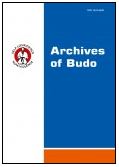2021, Volume 17
Reliability of karate-specific test and its associations with T-test and change of direction
Darjan Smajla1, Darjan Spudić2, Žiga Kozinc3, Nejc Šarabon4
1 University of Primorska, Faculty of Health Sciences | InnoRenew CoE, Human Health Department, Izola, Slovenia
2Faculty of Sports, University of Ljubljana, Ljubljana, Slovenia
3Faculty of Health Sciences, University of Primorska, Izola, Slovenia
4University of Primorska, Faculty of Health Sciences | InnoRenew CoE, Human Health Department | S2P, Science to practice, Ltd., Laboratory for Motor Control and Motor Behavior, Ljubljana, Slovenia
Author for correspondence: Nejc Šarabon; University of Primorska, Faculty of Health Sciences | InnoRenew CoE, Human Health Department | S2P, Science to practice, Ltd., Laboratory for Motor Control and Motor Behavior, Ljubljana, Slovenia
Full text
Abstract
Background and Study Aim: There is a lack of the test for evaluation sport-specific movements in karate. The aim of this study was empirical argumentation about reliability of karate-specific test (KSAT) and its associations with T-test and change of direction (CoD).
Material and Methods: The decomposition of the project goal into research tasks was based on three procedures: 1) to evaluate within-session reliability of newly introduced KSAT; 2) investigate correlations with CoD, T-test and training years; 3) to assess differences in tests performed on the preferred and non-preferred side/guard. The research was conducted among 39 elite karatekas (age: 19.3 ±0.1 year; training years’ experience: 11.5 ±4.7). Participants performed the CoD test at 90° and 180°, T-test, and short and long KSAT.
Results: Our results showed good to excellent ICC2.1 values and acceptable CV (<10%) and TE values for all agility tests. There was significant positive moderate correlation between the time in short KSAT in non-preferred guard and T-test. A greater number of moderate to large correlations were seen between long KSAT in non-preferred guard and agility test. Significant negative moderate to large correlations were found between training years and KSAT time. There were no significant differences between agility tests or KSAT comparing the preferred or non-preferred sides. The newly introduced KSAT test was shown as a potentially useful tool for evaluating the speed of movement in karate guard position. Moreover, correlations between training years and KSAT performance confirmed its specificity and relevance for measuring the performance of specific karate movement.
Conclusions: Coaches and practitioners can use the KSAT test for evaluating the movement of karatekas in preferred and non-preferred guards to detect weak points of movement.
Key words: agility, movement, guard, speed, kumite




